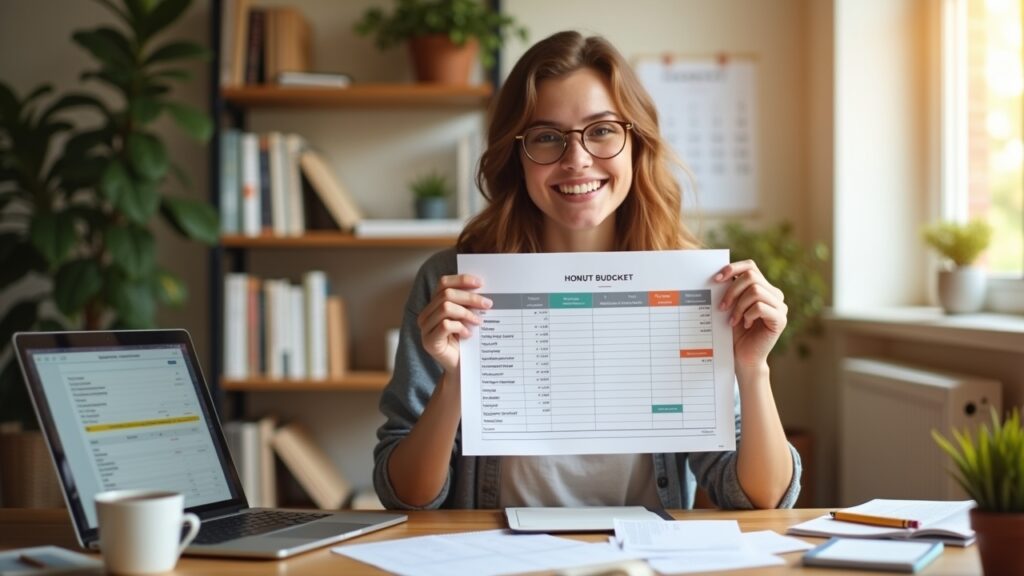Advertisements
Did you know that 65% of Americans have no idea how much they spent last month? I used to be one of them! My first attempt at budgeting was such a disaster that I actually ended up spending MORE money than before I started tracking it.
Creating your first budget doesn’t have to be complicated, though. After years of trial and error (and one particularly embarrassing incident involving three streaming subscriptions I forgot I had), I’ve finally cracked the code.
Let me walk you through exactly how to create a budget that actually works – not some fancy spreadsheet you’ll abandon after two weeks.
Why Your First Budget Will Probably Suck (And That’s Totally Fine)

When I made my first budget back in 2019, I was so confident. I’d downloaded this gorgeous budget template, color-coded everything, and felt like a financial genius. Two weeks later, I’d blown through my “fun money” category and was stealing from my grocery budget to buy coffee.
Here’s what nobody tells you about budgeting for beginners – your first one is basically a rough draft. You’re gonna mess up the numbers because you probably don’t even know what you actually spend on stuff. I thought I spent maybe $200 a month eating out. The real number? Try $487!
The good news is that starting badly is still better than not starting at all. Your budget is supposed to evolve as you learn more about your spending habits.
The Dead-Simple Way to Track Your Current Spending
Before you can create a realistic budget, you gotta know where your money’s actually going. I know, I know – this part’s about as fun as watching paint dry.
Here’s my lazy person method that actually works:
- Download your last three months of bank statements
- Grab a highlighter (or use the search function if you’re digital)
- Pick five main categories: Housing, Food, Transportation, Fun Stuff, Everything Else
- Add up each category and divide by three for your monthly average
Don’t get fancy with 47 different categories yet. When I tried that, I spent more time categorizing transactions than actually looking at where I could save money. Keep it simple at first – you can always get more detailed later.
Pro tip: Those little $5-15 purchases are probably killing your budget more than you think. My coffee shop visits were costing me $180 a month, which was basically a car payment!
Building Your First Budget (Without Losing Your Mind)
Alright, now for the main event. There’s tons of budgeting methods out there – 50/30/20, zero-based, envelope method… honestly, they all made my head spin when I started.
Here’s what finally worked for me:
Step 1: List your income after taxes. This is what actually hits your bank account. If you’re irregular income like me (freelance life!), use your lowest earning month from the last six months.
Step 2: Write down your fixed expenses. Rent, car payment, insurance – the boring stuff that stays the same each month. These are non-negotiable unless you wanna live in your car.
Step 3: Set aside money for savings FIRST. I cannot stress this enough! Even if it’s just $50, pay yourself before you pay anyone else. I learned this the hard way after three years of “I’ll save whatever’s left” (spoiler: nothing was ever left).
Step 4: Budget for variable expenses. This is where it gets tricky. Use those averages you calculated earlier, but round up a bit. Trust me on this one.
Step 5: Give yourself some fun money. Seriously! Budgets that don’t include any enjoyment are like diets that ban all carbs – you’ll crash and burn spectacularly.
The Stupid-Simple Tools That Actually Help
You don’t need fancy software to budget. When I started, I used a notebook and calculator. But if you want to make life easier, here’s what I recommend:
- Mint – Free and connects to your bank accounts automatically
- YNAB (You Need A Budget) – Costs money but forces you to be intentional
- Good old Google Sheets – Free and customizable if you’re a control freak like me
I personally use Google Sheets now because I can obsessively check it on my phone whenever I want. Plus, there’s something satisfying about manually entering expenses – makes me think twice before buying stuff.
Whatever you choose, the best budgeting tool is the one you’ll actually use. Don’t let perfect be the enemy of good enough.
Common First Budget Mistakes (I Made All of These)
Let me save you some pain by sharing my greatest hits of budgeting fails:
Forgetting irregular expenses. You know what derailed my budget every single time? Car registration, Amazon Prime renewal, birthday gifts. Now I divide these yearly expenses by 12 and save monthly.
Being too restrictive. My second budget allocated $50 for groceries per week. For two people. Including toiletries. Yeah, that lasted exactly one shopping trip.
Not tracking daily. I used to check my budget once a month and act surprised when I was over. Now I do a quick 2-minute check every morning with my coffee. Game changer!
Giving up after one bad month. February 2020, I went 40% over budget because of a surprise vet bill. Instead of adjusting, I just threw in the towel for six months. Don’t be like past me.
Your Budget, Your Rules
Here’s the thing about personal budgeting – it’s gotta work for YOUR life. My budget includes a line item for plants (don’t judge), while my best friend budgets for vintage vinyl records.
The perfect budget is one that helps you pay your bills, save some money, and still enjoy life. It might take a few months to find your groove, and that’s totally normal. I’m still tweaking mine after all these years!
Remember, creating your first budget is just the beginning. It’s gonna feel weird and probably won’t be perfect, but you’re already ahead of most people just by starting. Keep at it, be patient with yourself, and don’t forget to celebrate the small wins along the way.
Want more practical money tips that actually work in real life? Check out other posts on Cashflow Zen where we keep it real about finances without the boring lectures!



